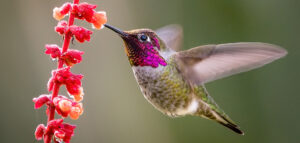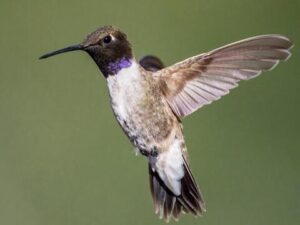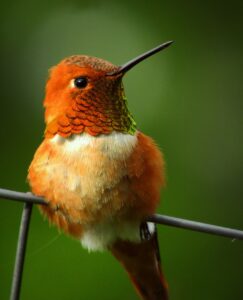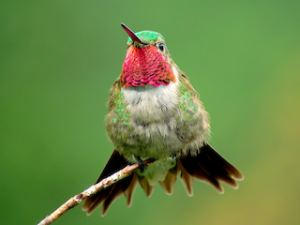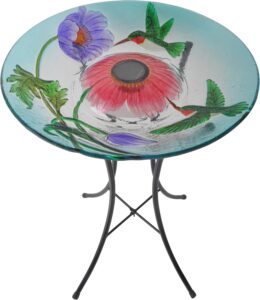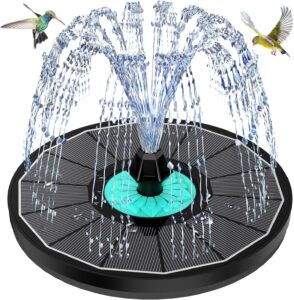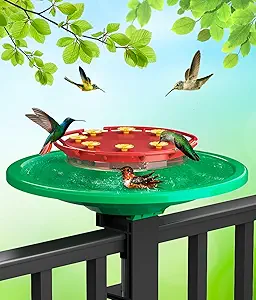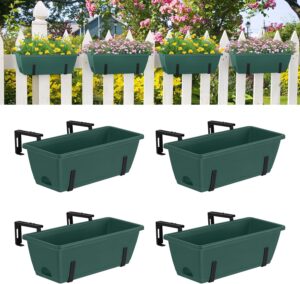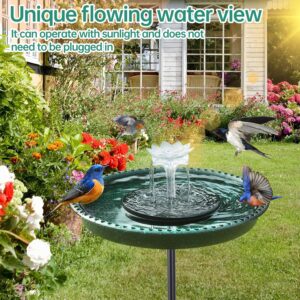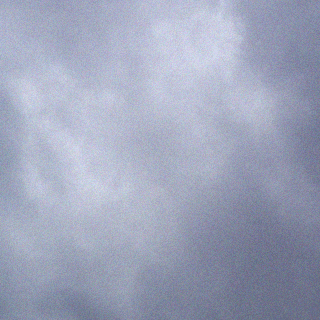Arizona is a hummingbird enthusiast’s paradise, boasting an incredible diversity of species and habitats. With its arid deserts, lush riparian areas, and mountainous regions, the state provides a home or migratory stop for at least 15 species of hummingbirds. Whether you’re in Phoenix, Tucson, or a rural canyon, you can create a hummingbird-friendly environment that attracts these vibrant birds year-round. This guide will provide detailed insights into Arizona’s hummingbirds, native plants, and strategies for urban and rural settings.
Hummingbird Species in Arizona
Arizona is home to more hummingbird species than any other state in the U.S., making it a hotspot for birdwatchers. Here are some of the key species you might encounter:
-
Anna’s Hummingbird (Calypte anna)
-
Range: Found year-round in central and southern Arizona, especially in urban areas like Phoenix and Tucson.

Anna’s Hummingbird -
Identification: Males have iridescent magenta crowns and throats, while females are olive-green with flecks of color on their chins.
-
Behavior: Known for their dramatic courtship dives and frequent visits to feeders.
-
-
Black-chinned Hummingbird (Archilochus alexandri)

Black-chinned Hummingbird -
Range: Common during spring and summer throughout Arizona’s riparian areas.
-
Identification: Males have a black throat with a violet band at the base; females are duller with white-tipped tails.
-
Behavior: Prefers shaded areas near water.
-
-
Broad-billed Hummingbird (Cynanthus latirostris)

Broad-billed hummingbird -
Range: Breeds in southern Arizona canyons from March to October.
-
Identification: Males have bright blue throats and red bills with black tips; females are green with faint eye stripes.
-
Behavior: Often seen feeding at dusk.
-
-
Costa’s Hummingbird (Calypte costae)

Costa’s hummingbird -
Range: Found in the Sonoran Desert during spring and summer.
-
Identification: Males have striking purple crowns and throats that extend into flared “mustaches.”
-
Behavior: Adapted to hot, arid environments.
-
-
Rufous Hummingbird (Selasphorus rufus)

Rufous hummingbird -
Range: A migratory species passing through Arizona during spring and fall migrations.
-
Identification: Males are fiery orange with white chests; females are green with orange sides.
-
Behavior: Highly territorial at feeders.
-
-
Broad-tailed Hummingbird (Selasphorus platycercus)

Broad-tailed-Hummingbird -
Range: Common in mountainous regions during summer breeding season.
-
Identification: Males have ruby-colored throats; both sexes have broad tails with green backs.
-
Other notable species include the Violet-crowned Hummingbird, Blue-throated Mountain-gem, Lucifer Hummingbird, and Calliope Hummingbird.
Seasonal Timing
Understanding the seasonal habits of Arizona’s hummingbirds is crucial for attracting them:
-
Spring Arrival (March–April): Migratory species like Rufous and Black-chinned Hummingbirds arrive as early as March.
-
Breeding Season (May–August): Many species nest during this time; feeders are essential for supporting nesting females.
-
Fall Migration (August–October): Rufous Hummingbirds pass through again on their way south.
-
Year-Round Residents: Anna’s Hummingbirds can be seen throughout the year, particularly in urban areas.
Feeding Guidelines
Providing food through feeders is one of the easiest ways to attract hummingbirds:
Nectar Recipe
-
Mix 1 part white granulated sugar with 4 parts water.
-
Boil briefly to dissolve sugar completely, then cool before filling feeders.
-
Avoid red dye or honey, which can harm hummingbirds.
Feeder Maintenance
-
Clean feeders every 3–5 days in warm weather to prevent mold or fermentation.
-
Use a bottle brush to scrub hard-to-reach areas.
-
In cooler months, clean feeders weekly.
-
Guide for when to change the nectar
Letting the nectar ferment encourages mold growth, which makes the cleaning process more difficult. To avoid this, follow the chart below for recommended nectar changes based on the temperature. The hotter it gets, the more frequently you’ll need to replace the nectar.
High temperatures…………Change after
71-75……………………………6 days
76-80……………………………5 days
81-84……………………………4 days
85-88……………………………3 days
89-92……………………………2 days
93+………………………………change daily
Click on the link for a detailed guide to help youclean your hummingbird feeder, especially when mold starts to grow due to nectar not being changed in time.
Placement Tips
-
Place feeders near flowering plants to mimic natural feeding conditions.
-
Position them in shaded areas to keep nectar fresh longer.
-
Provide multiple feeders spaced apart to reduce territorial disputes.
Native Plants for Hummingbirds
Arizona’s native plants are perfectly adapted to attract hummingbirds while thriving in the state’s arid climate. Incorporating these plants into your garden creates a sustainable food source that complements feeders.
VIDEO:A close look at Arizona’s 14 hummingbird species and where to find them.
Top Native Plants for Arizona
-
Ocotillo (Fouquieria splendens)
-
Tall spiny stems topped with bright red flowers in spring.
-
A vital nectar source during migration.
-
-
Chuparosa (Hummingbird Bush) (Justicia californica)
-
Tubular red flowers bloom from late winter to spring.
-
Thrives in desert landscapes with minimal water.
-
-
Desert Willow (Chilopsis linearis)
-
Produces fragrant pink or lavender flowers from spring through fall.
-
Ideal for riparian areas or xeriscaping.
-
-
Hummingbird Trumpet (Epilobium canum)
-
Low-growing plant with fiery red flowers blooming late summer into fall.
-
Perfect for rock gardens or borders.
-
-
Red Bird of Paradise (Caesalpinia pulcherrima)
-
Showy orange-red flowers attract hummingbirds throughout summer.
-
Thrives in full sun and heat.
-
-
Sonoran Honeysuckle (Justicia sonorae)
-
A drought-tolerant shrub with orange tubular flowers that bloom year-round in warm climates.
-
-
Parry’s Penstemon (Penstemon parryi)
-
Tall spikes of pink flowers bloom in early spring.
-
Easy to grow from seed and highly attractive to pollinators.
-
-
Woolly Butterfly Bush (Buddleja marrubiifolia)
-
Compact shrub with orange ball-shaped flowers.
-
Provides nectar during summer months.
-
-
Yucca Species
-
Stalks of creamy white flowers provide nectar while also attracting insects that hummingbirds eat.
-
-
Golden Currant (Ribes aureum)
-
Yellow flowers bloom early in spring, providing food for migrating birds.
-
Planting Tips
-
Group plants with similar water needs together (e.g., xeriscaping).
-
Use mulch to retain moisture around roots.
-
Avoid pesticides that could harm hummingbirds or their insect prey.
-
Incorporate flowering trees like mesquite or palo verde for shade and additional nectar sources.
Expanded Urban Strategies
Urban areas like Phoenix and Tucson offer plenty of opportunities to attract hummingbirds despite limited space:
Container Gardening
Container gardening is one of the most versatile and accessible ways to attract hummingbirds, especially in Arizona’s diverse climate. Whether you have a small patio, balcony, or even just a sunny windowsill, creating a hummingbird-friendly container garden can bring these vibrant birds right to your doorstep. Here’s an in-depth look at how to design, plant, and maintain a container garden that will keep hummingbirds coming back for more.
Choosing the Right Containers
The type of container you use can significantly impact the success of your hummingbird garden. Here are some key considerations:
-
Size Matters:
-
Larger pots (at least 12–20 inches in diameter) are ideal because they retain moisture longer, reducing watering frequency in Arizona’s dry climate
-
-
-
.Smaller containers work well for compact spaces but may require more frequent watering.
-
-
Material Options:
-
Plastic: Lightweight and affordable, plastic containers are easy to move but may heat up quickly in full sun.
-
Ceramic or Terracotta: These materials add aesthetic appeal but can be heavy and prone to cracking in extreme temperatures.
-
Wire Baskets with Moss Liners: Perfect for hanging gardens, these allow planting on the sides for a fuller display
-
.Drainage:
-
Ensure all containers have drainage holes to prevent waterlogging, which can damage roots
-
-
-
.For larger containers, consider placing recycled water bottles or milk jugs at the bottom to reduce soil usage and improve drainage
-
.Creative Containers
-
-
-
Repurpose items like old wheelbarrows or wooden crates as unique planters. Adding drainage holes transforms them into functional garden pieces
-
-
-
.Selecting Plants for Containers
-
Hummingbirds are drawn to flowers rich in nectar, particularly those with tubular shapes and bright colors like red, orange, and pink. Here are some top choices for container gardening in Arizona:
-
Salvia (Sage):
-
Varieties like Autumn Sage (Salvia greggii) or Pineapple Sage (Salvia elegans) produce bright red blooms that hummingbirds love
-
-
-
.Salvia thrives in full sun and is drought-tolerant, making it ideal for Arizona’s climate.
-
-
Petunias:
-
Easy to grow and available in various colors, petunias are perfect for filling out containers and attracting hummingbirds
-
.Use trailing varieties like ‘Wave Petunias’ for a cascading effect.
-
-
Chuparosa (Justicia californica):
-
Known as the “hummingbird bush,” this native plant produces tubular red flowers that bloom from late winter into spring
-
.Lantana:
-
A hardy plant with clusters of nectar-rich flowers in vibrant shades of orange and yellow
-
-
.Perfect for sunny spots and requires minimal care.
-
Penstemon (Beardtongue):
-
Parry’s Penstemon (Penstemon parryi) is a native favorite with tall spikes of pink flowers that bloom early in spring
-
.Fuchsia:
-
Ideal for hanging baskets, fuchsia produces dangling tubular flowers that hummingbirds adore
-
-
.Nasturtiums:
-
These edible plants feature bright orange or yellow blooms that attract hummingbirds while adding color to your garden.
-
-
-
Golden Currant (Ribes aureum):
-
Produces yellow flowers early in spring, providing nectar during migration periods
-
.
Designing Your Container Garden
Creating an eye-catching container garden involves thoughtful arrangement and layering:
- Layered Approach:
-
Place taller plants like salvia or penstemon in the center of the container.
-
Surround them with medium-sized plants such as lantana or petunias as fillers.
-
Add trailing plants like nasturtiums around the edges for visual interest
-
-
-
.Color Scheme:
-
Focus on red, orange, pink, and purple blooms to attract hummingbirds from afar
-
-
.Grouping Containers:
-
Arrange multiple containers together for greater impact and increased chances of visits from hummingbirds.
-
Adding Water Features
-
-
Hummingbirds love water not only for drinking but also for bathing:
-
Install shallow bird baths with gently sloping edges. Hummingbirds prefer water sources that are no more than 1-1.5 inches deep.

-
Incorporate small fountains or misters into your container garden setup to create a refreshing oasis
-
.Use shallow dishes filled with fresh water near flowering plants to encourage visits.
-
Consider adding a mister or dripper to create moving water, which attracts hummingbirds. They often enjoy flying through fine sprays of water.

Placement Tips
Strategic placement ensures your container garden is both functional and enjoyable:
-
Sunlight Requirements:
-
Most nectar-rich plants require at least 6 hours of sunlight daily
-
-
-
. Morning sun is ideal as it prevents overheating during peak afternoon temperatures.
-
-
Visibility:
-
Position containers near windows or patios where you can easily observe visiting hummingbirds
-
.
-
Accessibility:
-
Ensure there’s enough open space around containers for hummingbirds to fly in and out freely.
-
Care and Maintenance
Proper care keeps your container garden thriving throughout the season:
-
Watering:
-
Check soil moisture regularly by sticking your finger into the top 2 inches of soil
-
-
-
. Water when dry until excess flows out of the drainage holes.
-
-
Fertilizing:
-
Use slow-release fertilizers every 3 months to ensure consistent blooms
-
-
-
. Liquid fertilizers can be applied biweekly during peak growing seasons.
-
-
Pruning:
-
Deadhead spent flowers to encourage new growth and maintain a tidy appearance.
-
-
Why Container Gardening Works Well in Arizona
Arizona’s climate is uniquely suited for container gardening due to its variability across regions:
-
In urban areas like Phoenix or Tucson, containers allow gardeners to create lush spaces despite limited ground space or poor soil quality.
-
In rural areas, container gardens can supplement larger landscapes by adding concentrated nectar sources near patios or outdoor seating areas.
-
The portability of containers makes it easier to move plants into shaded areas during extreme heat or protect them from frost during cooler months.
By combining thoughtfully chosen plants with strategic placement and proper care techniques, you can create a stunning container garden that attracts hummingbirds year-round—even in Arizona’s challenging climate! Whether you’re working with a small balcony or expansive patio space, container gardening offers endless possibilities for bringing these flying jewels closer to home.
-
Balcony Feeders
Balcony setups can be highly effective:
-
Enhancing Your Balcony Setup
- Hummingbirds enjoy fresh water to drink and bathe. A shallow birdbath with a fine spray from a mister is ideal. Just make sure the water is changed regularly to keep it clean.
- Here’s a solar powered bird bath.
-

-
Flower Pots and Rail Boxes
-
- Install compact feeders designed for small spaces.
-
Surround feeders with potted nectar-rich plants like fuchsia or lantana.
-
Use hanging baskets filled with petunias or calibrachoa to create a layered feeding environment.
-
Clamp-On Feeders: These feeders attach securely to balcony railings, saving space while keeping the feeder stable during windy conditions.
-

Deck Hook for Bird Feeder
-
Deck Railing Planter Balcony Hanging Planters with Adjustable Flower Box Brackets

Expanded Rural Strategies
Rural areas provide ample space to create expansive hummingbird habitats:
Wildflower Meadows
Transform open spaces into wildflower meadows:
-
Include native species like golden currant, desert willow, and firecracker penstemon.
-
Allow some areas to grow naturally without mowing.
Water Features
Add birdbaths or fountains near flowering plants:
-
Running water attracts thirsty birds while enhancing your landscape.
-
Ensure water features are shallow enough for small birds to use safely.
- Hummingbirds enjoy fresh water to drink and bathe. A shallow birdbath with a fine spray from a mister is ideal. Just make sure the water is changed regularly to keep it clean.
Here’s a solar powered bird bath.Hummingbird misters at Amazon.com
-
Tree Plantings
Incorporate flowering trees like mesquite or palo verde:
-
Provide shade along with nectar-rich blooms.
-
Create windbreaks around gardens to protect feeding areas from strong gusts.
Climate Challenges and Adaptations
Arizona’s extreme heat poses unique challenges:
-
Use drip irrigation systems to keep plants hydrated without wasting water.
-
Plant heat-tolerant species like ocotillo or yucca that require minimal care.
-
Provide shaded feeding stations during peak summer temperatures.
Special Tips for Arizonan Birders
-
Visit hotspots like Madera Canyon, Ramsey Canyon Preserve, or Patagonia-Sonoita Creek Preserve for unparalleled birdwatching opportunities.
-
Participate in citizen science programs such as Audubon’s Hummingbirds at Home to track sightings and contribute to conservation efforts.
-
Install motion-sensitive cameras near feeders to capture close-up footage of visiting birds!
Conclusion
By focusing on native plants, tailored urban strategies, expansive rural solutions, and year-round support systems like feeders, you can create a thriving habitat for hummingbirds across Arizona’s diverse landscapes! Whether you’re welcoming migratory Rufous Hummingbirds or supporting Anna’s year-round residents, your efforts will ensure these incredible birds continue to flourish!
Hummingbird Resources
Here’s a complete guide to attracting hummingbirds to your yard. It lists plants, vines and shrubs that are in bloom for spring, summer and fall. Your hummingbirds will always have flowers to feed on.
Here’s a great article that tells everything you need to know about how to choose the best place to hang your hummingbird feeder.
Here’s the best designed hummingbird feeder to use. It’s leak proof, so it won’t attract insects and it’s easy to take apart and clean.
Here’s a comprehensive guide to help you clean your hummingbird feeder for those times when the nectar is not changed soon enough and mold starts to grow.
Here’s a guide to keeping ants and bees off your hummingbird feeder
If you found this article helpful please share it with your friends using the social bookmarking buttons on the left side of this page. Help everyone to increase their knowledge and enjoyment of feeding hummingbirds. Do it for the hummingbirds! It also helps my ranking so my information will be available to more people. The more people that see this vital information, the more the hummingbirds are helped. Thank for your help. The hummingbirds and I appreciate you very much!
